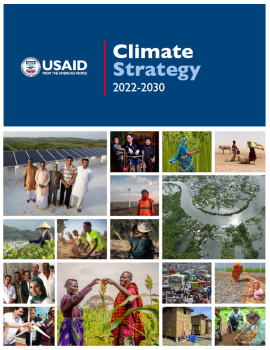Climate change is a global crisis. As temperatures and sea levels rise, people around the world are increasingly seeing heatwaves, droughts, floods, cyclones, and wildfires upend their lives. The effects of climate change are not equal – they disproportionately impact the poorest and most marginalized communities USAID works to support every day. Climate change affects virtually everything that USAID does and threatens the development progress it has supported over more than 60 years.
Climate change increases water and food scarcity, displacement, and the need for humanitarian assistance, as well as contributes to conflict and disrupts economic stability. Yet at the same time, USAID’s response presents an opportunity to improve livelihoods. Decarbonizing economies means less air pollution that negatively affects health. Building climate-resilient infrastructure means people are safer when disaster strikes and reduces the need for costly repairs after every storm. Investing in green jobs presents an opportunity to make workforces more equitable and inclusive.
That is why USAID has developed a new Climate Strategy that will guide its work through 2030. This new Strategy takes a “whole-of-Agency” approach that calls on all corners of USAID to play a part in the response. USAID will work on the ground with partner governments and local actors to set the global trajectory toward a vision of a resilient, prosperous, and equitable world with net-zero greenhouse gas emissions.
Addressing the climate crisis requires a holistic approach to development. Every USAID sector and Mission has a role to play in transforming global systems like agriculture, energy, governance, infrastructure, and health. This Strategy includes six ambitious high-level Targets that reflect how a whole-of-Agency approach can increase USAID’s impact. USAID will update these 2030 Targets and supplement them with interim Targets throughout the Strategy’s lifetime.
USAID’s Climate Strategy is built on several foundational principles, which will be incorporated into all planning and activities: Locally-led Development, Equity and Inclusion, Private Sector Engagement, Nature-based Solutions, and Evidence, Technology, and Innovation.
Climate Change and Water Security
Water security is under threat worldwide from a changing climate, and roughly half of the world’s population experience severe water scarcity for at least some part of the year due to climatic and non-climatic drivers. The increasing frequency of extreme weather events such as floods and droughts, alongside increasing global average temperatures, will put further pressure on infrastructure and water resources. At the same time, many of the most immediate climate adaptation needs, particularly in developing countries, are related to improving water resource management and ensuring access to water and sanitation services.
Through its Water for the World programming, USAID is contributing to climate adaptation by helping partner countries build sustainable, climate-resilient water and sanitation services. We are working with utilities and governments to identify and proactively managing risks of climate change; improv overall adaptive capacity; and expand access to at least basic sanitation which is critical to ensure healthy populations in the face of climate change; and invest in improved water resources management as one of the most cost-effective and important ways to adapt to climate change.
Water also has an important role to play in mitigation as reducing emissions in water and sanitation systems to achieve lasting and feasible net-zero and climate-resilient pathways USAID intends to leverage $1 billion dollars in public and private finance for climate-resilient water and sanitation services by 2030.
Visit the Climate Hub on Climatelinks to learn more about USAID’s new Climate Strategy:
- Strategic Objective 1: Targeted Direct Action - Accelerate and scale targeted climate actions.
- Strategic Objective 2: Systems Change - Catalyze transformative shifts to net-zero and climate-resilient pathways.
- Special Objective 3: Do Our Part - Strengthen operations and approaches to programming to address climate change and further climate justice within USAID and our partner organizations.
The Strategy is also available in French, Spanish, and Arabic.


